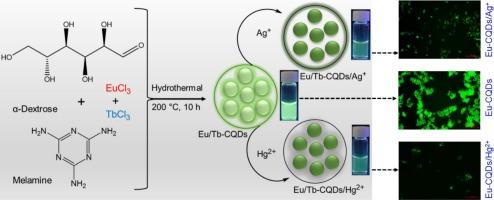双稀土金属掺杂碳量子点光致发光传感器的合成及其在细胞内生物成像中的应用
IF 4.7
3区 化学
Q2 CHEMISTRY, PHYSICAL
Journal of Photochemistry and Photobiology A-chemistry
Pub Date : 2025-10-07
DOI:10.1016/j.jphotochem.2025.116823
引用次数: 0
摘要
碳量子点(CQDs)由于其高水溶性、低成本和优异的生物相容性而在生物医学领域得到了广泛的应用。在这项工作中,铕和铽装饰的碳量子点(Eu/Tb-CQDs)作为光致发光传感器,用于细胞内生物成像检测Ag+和Hg2+。以α-葡萄糖和三聚氰胺为碳氮源,EuCl3/TbCl3为双金属掺杂,合成了Eu/Tb-CQDs。在这方面,Eu3+/Tb3+离子与CQDs表面的羟基和羧酸氧之间的强配位使它们能够结合到碳核中。通过紫外-可见/光致发光(PL)光谱、FTIR、XRD、TEM和XPS等分析手段对合成的Eu/Tb-CQDs进行了全面表征。在338 nm激发下,合成的Eu/Tb-CQDs在519 nm处表现出与激发相关的发光峰特征。制备的Eu/Tb-CQDs尺寸为4.13±0.18 nm,量子产率为26.2±0.4%。所得Eu-GQDs作为一种新型的“开-关”光致发光探针,具有较高的灵敏度和选择性,可用于银+和Hg2+离子的无标记测定。荧光强度(P0/P)与Ag+和Hg2+离子浓度在0 ~ 10 μM范围内呈良好的线性关系(R2 = 0.9949和0.9905),检出限(LOD)分别为50.1 nM (Ag+)和33.3 nM (Hg2+)。EDTA连续加入Ag+和Hg2+离子可以可逆地恢复PL强度。该方法在自来水和湖水的真实水样中显示出很强的可靠性,表明其在复杂环境中监测Ag+和Hg2+的潜在用途。此外,Eu/Tb-CQDs具有良好的水分散性和较低的细胞毒性,在生物成像方面具有很大的应用潜力。本文章由计算机程序翻译,如有差异,请以英文原文为准。

Facile synthesis of dual rare earth metal-doped carbon quantum dots as photoluminescent sensors for Ag+ and Hg2+ detection with intracellular bioimaging applications
Carbon quantum dots (CQDs) have attracted a lot of attention in biomedical applications because of their high-water solubility, low cost, and excellent biocompatibility. In this work, europium and terbium-decorated carbon quantum dots (Eu/Tb-CQDs) as photoluminescent sensors for Ag+ and Hg2+ detection with intracellular bioimaging applications. Eu/Tb-CQDs were synthesized using α-dextrose and melamine as a carbon and nitrogen source and EuCl3/TbCl3 as a dual metal doping. In this aspect, the strong coordination between the Eu3+/Tb3+ ions and the hydroxyl and carboxylate oxygen at the CQDs surface allows them to be combined into the carbon core. The as-synthesized Eu/Tb-CQDs were thoroughly characterized by using various analytical such as UV–visible/photoluminescence (PL) spectroscopy, FTIR, XRD, TEM, and XPS analysis. The as-synthesized Eu/Tb-CQDs exhibited a characteristic excitation-dependent PL emission peak at 519 nm upon excitation at a wavelength of 338 nm. The size of the as-prepared Eu/Tb-CQDs is 4.13 ± 0.18 nm with a high quantum yield of 26.2 ± 0.4 %. The obtained Eu-GQDs were used as a new “on-off” Photoluminescent probe for the label-free determination of Ag+ and Hg2+ ions with high sensitivity and selectivity. In addition, a good linear relationship between PL intensity (P0/P) vs. Ag+ and Hg2+ ions concentration in the range of 0 to 10 μM (R2 = 0.9949 and 0.9905) with limit of detection (LOD) of 50.1 nM (Ag+) and 33.3 nM (Hg2+). The sequential addition of EDTA with Ag+ and Hg2+ ions can recover the PL intensity in a reversible manner. The assay notably showed strong reliability for real water samples in tap water and lake water indicating its potential uses for monitoring Ag+ and Hg2+ in complex environments. Besides, the Eu/Tb-CQDs holds good aqueous dispersibility and low cytotoxicity, which shows great potential applications in bioimaging.
求助全文
通过发布文献求助,成功后即可免费获取论文全文。
去求助
来源期刊
CiteScore
7.90
自引率
7.00%
发文量
580
审稿时长
48 days
期刊介绍:
JPPA publishes the results of fundamental studies on all aspects of chemical phenomena induced by interactions between light and molecules/matter of all kinds.
All systems capable of being described at the molecular or integrated multimolecular level are appropriate for the journal. This includes all molecular chemical species as well as biomolecular, supramolecular, polymer and other macromolecular systems, as well as solid state photochemistry. In addition, the journal publishes studies of semiconductor and other photoactive organic and inorganic materials, photocatalysis (organic, inorganic, supramolecular and superconductor).
The scope includes condensed and gas phase photochemistry, as well as synchrotron radiation chemistry. A broad range of processes and techniques in photochemistry are covered such as light induced energy, electron and proton transfer; nonlinear photochemical behavior; mechanistic investigation of photochemical reactions and identification of the products of photochemical reactions; quantum yield determinations and measurements of rate constants for primary and secondary photochemical processes; steady-state and time-resolved emission, ultrafast spectroscopic methods, single molecule spectroscopy, time resolved X-ray diffraction, luminescence microscopy, and scattering spectroscopy applied to photochemistry. Papers in emerging and applied areas such as luminescent sensors, electroluminescence, solar energy conversion, atmospheric photochemistry, environmental remediation, and related photocatalytic chemistry are also welcome.

 求助内容:
求助内容: 应助结果提醒方式:
应助结果提醒方式:


